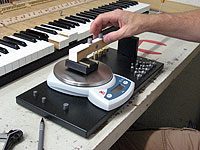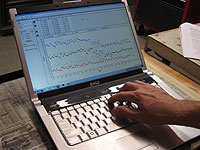Touchweight is a complicated subject that deals with how a piano feels when played at various speeds and dynamic levels. Some pianos feel fast and lightweight, while others may feel heavy and sluggish.
The subject of touchweight deals with several laws of physics: friction, static motion, and inertia. Pianos are affected by all three of these physical properties and each of them must be carefully analyzed and addressed as part of a thorough Touchweight correction project.
Determining if a Piano has Touchweight Problems
Before beginning any Touchweight analysis and correction job, I like to talk directly to the pianist(s) about their concerns regarding the problems and expectations they have about the piano. This gives me some great insight not only about the piano itself, but also what the player expects from it and where it is falling short. Sometimes, the problem may have something to do with the player as well as the piano itself. So, it’s important to bring this out at the beginning.
 I also like to play the instrument myself, as a way of learning about the subtle nuances of its current touch parameters. Does it respond to different dynamic ranges? Can I control pianissimo passages easily? Do the keys feel light or heavy or somewhere in between? Does it repeat quickly? Does the touch feel even from note to note? Do my hands and arms tire easily from playing it? These are some of the things I look for when assessing the touch of a piano.
I also like to play the instrument myself, as a way of learning about the subtle nuances of its current touch parameters. Does it respond to different dynamic ranges? Can I control pianissimo passages easily? Do the keys feel light or heavy or somewhere in between? Does it repeat quickly? Does the touch feel even from note to note? Do my hands and arms tire easily from playing it? These are some of the things I look for when assessing the touch of a piano.
Often times, when a piano has a less than stellar touch, the action is in need of regulation. So, it’s important to analyze the action to determine if this is contributing to the problem as well. Many times a poorly regulated action is the primary cause of a bad touch. And, many times I perform both a thorough action regulation and a touchweight correction as part of a complete piano performance improvement. Many of the factors that affect touchweight are really action regulation problems. The two go hand in hand, so you really cannot address touchweight without looking at and possibly correcting action regulation issues first.
Touchweight Correction Tools
 At Ron Kneale Piano Service, we have a variety of tools at our disposal to analyze and precisely adjust the touch of a piano. Computer programs, precision digital scales, high-tech jigs, and thorough training allow us to analyze and quickly correct even the toughest touchweight problems.
At Ron Kneale Piano Service, we have a variety of tools at our disposal to analyze and precisely adjust the touch of a piano. Computer programs, precision digital scales, high-tech jigs, and thorough training allow us to analyze and quickly correct even the toughest touchweight problems.
Addressing touchweight issues on a poorly performing instrument can be one of the most rewarding aspects of piano service. Unlike piano tuning, changes made to a piano’s touch are permanent and often result in an average piano suddenly becoming the “favorite one to play on”.